Dragon in Chanoyu Part 2
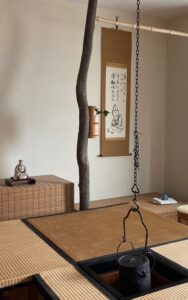
Ga-ran-dō, 伽蘭洞, Help-orchid-cave, set with utensils for March, when we have memorials for Sen no Rikyū. Kakemono picturing Rikyū by by Sen-gai Gi-bon, 仙厓義梵, Hermit-precipice Righteous-Sanskrit. [1750-1837]. Tsuri-gama, 釣釜, suspend-kettle: the un-ryū gama, 雲龍釜, cloud-dragon kettle, is suspended over the ro from a kusari, 鎖, chain. There is no need of a go-toku, 五徳, five-virtue, trivet, to support the kama. The tsuri-gama is used by Urasenke in March, the third month. The third month is identified with the zodiac sign Tatsu, 辰, Dragon. The utensils pictured with the tsuri-gama are for Rikyū’s memorial Tea observed on March 28.
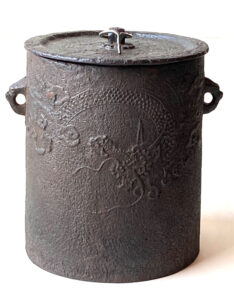
The Unryū gama features a raised design of a dragon, depicting its head and right front claw with three talons holding a hō-ju, 宝珠, treasure-jewel, its left claw empty, and its body partially hidden among clouds. On the opposite side is depicted ‘rain’ falling from its body and cloud forms; H. 5 sun kujira-jaku. The cylindrical form is identified as hitoe-guchi, 単口, single layer-opening. The pictured unryū gama is often used suspended over the ro, it could also be supported on a trivet, go-toku, 五徳, five-virtue. A smaller version is suitable for use with the portable fu-ro, 風炉, wind-hearth, and is supported on a gotoku.
Dragons in Buddhism, known as Nāgas, are revered as protectors of the Dharma as manifest in the Buddhist, Hō, 法, Natural Law. They symbolize transformation, wisdom, and sometimes, danger. Nāgas are often associated with water and weather. The relationship between Nāgas and Buddhist figures is highlighted in various texts. Dharma, written as Bon, 梵, refers to Brahman, and is a major concept with a wide variety of meanings in religions originating from India such as Hinduism, Buddhism, Jainism, and Sikhism.
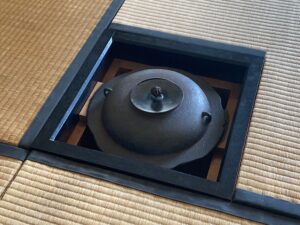
Suki-gi-gama, 透木釜, gap-wood-kettle: the kama is set in the ro with its wide flange, hane, 羽, wing, resting on small blocks of wood, sukigi, set on the ro-dan, 炉壇, hearth-foundation. There is no need of a gotoku to support the kama. The sukigi-gama is used by Urasenke in April, the fourth month. The fourth month is identified with the zodiac sign Mi, 巳, Snake. The signs of the Dragon and the Snake are joined together in the southeast, which is identified with the Kanji for Tatsumi, 巽, and the trigram, Son, ☴, Wind.
Urasenke Chanoyu uses the tsuri-gama in March, the third month, and the suki-gi-gama in April, the fourth month. Neighbor Omote-sen-ke, 表千家, Front-thousand-family, uses the tsuri-gama in April and the sukigi-gama in March. Great ancestor, Sen no Rikyū, wrote that if one had only a single kama, one could still make fine Tea. Metaphorically, Urasenke and Omotesenke have but one of each of the kama.
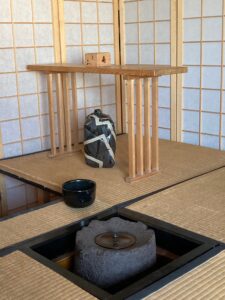
Ga-ran-dō, 伽蘭洞, Help-orchid-cave, set with utensils for the Lunar New Year of the Dragon, 2024. Ya-hazu gama, 矢筈釜, arrow-nock kettle. Ha-ssoku, 八足, eight-leg, hinoki, 桧, Japanese cypress, Shintō offering stand. Usu-ki, 薄器, tea-container, masu, 升, box measure, calligraphy by Hō-un-sai, 鵬雲斎, Phoenix-cloud-abstain. Mizu-sashi, 水指, water-indicate, ceramic, by Makoto Ya-be, 誠矢部, Truth Arrow-guild. Cha-wan, 茶碗, tea-bowl, ceramic with black glaze by Kuro-da Tatsu-aki, 黒田辰秋, Black-field Dragon-autumn.
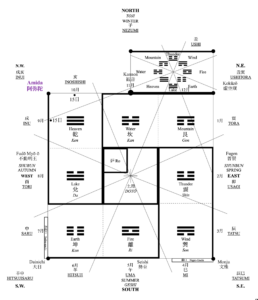
Diagram of a yo-jō-han, 四畳半, four-mat-half, showing various influences, including the jū-ni-shi, 十二支, ten-two-branches, the Asian zodiac with the sign of the Tatsu, 辰, Dragon, also joined with Mi, 巳, Snake, Tatsu-Mi, 辰巳, which is given the Kanji, Son, 巽, Wind. The ‘good wind’ blows from the southeast, which is the location of the nijiri-guchi, 躙口, crawl in-opening, to the Tearoom.
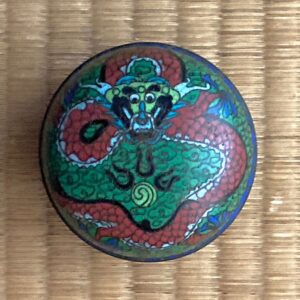
Round, covered container; copper with cloisonné, shi-ppō, 七宝, seven-treasures, with a design of a red dragon with five talons among green clouds and with the hō-ju, 宝珠, treasure-jewel; diam. 1.8 sun kujira-jaku. China. The number 18 is emblematic of Infinity in Space.
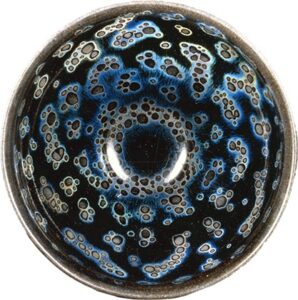
Yō-hen Ten-moku, 曜変天目, Heaven-eye, known as ‘Ina-ba Ten–moku’, 稲葉天目, Rice plant-leaf Heaven-eye, Song period 12〜13 cent. property of Ryū-kō-in, 龍光院, Dragon-light-sub temple, of Dai-toku-ji, 大徳寺, Great-virtue-temple. Koku-hō, 国宝, Country-treasure. This Teabowl is included because of its association with dragon as part of the name of the temple, Ryū-kō, Dragon-light. Currently located in the Seikado Bunko Art Museum.
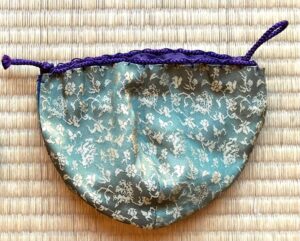
Shi-fuku, 仕覆, serve-cover, for a Ten-moku cha-wan, 天目茶碗, Heaven-eye tea-bowl, pouch of silk fabric with pattern of dragon and scrolling flowers, named, ‘Shu-kō don-su’, 珠光緞子, Jewel-light damask-of, identified with Mura-ta Shu-kō, 村田珠光, Town-field Jewel-light, Tea master and advisor to the Ashikaga family.
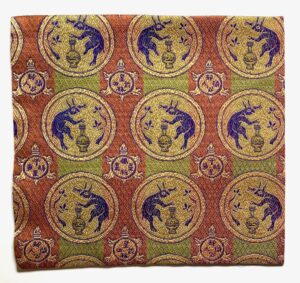
Ko-buku-sa, 古帛紗, old-cloth-gauze, silk square with a pattern of hares making an elixir of life on the moon, and turtles, fabricated by Tatsu-mura, 龍村, Dragon-town, Kyōto. The pattern was inspired by the Tai-ma Man-da-ra, 當麻曼荼羅, Accept-hemp Wide-weed-spread, a treasure of Tai-ma–dera, 當麻寺, Accept-hemp-temple, in Nara.

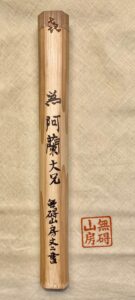
Cha-shaku tomo-zutsu, 茶杓共筒, tea-scoop together-cylinder, take, 竹, bamboo, with stopper made of sugi, 杉, cedar, branded with Kanji ki, 㐂, Joy; L. 8.2 sun kane-jaku, by Kuro-da Tatsu-aki, 黒田辰秋, Black-ricefield Dragon-autumn, Hino, 日野, Sun-field; Nin-gen Koku-hō, 人間国宝, Person-space Country-treasure, for carpentry. The tomozutsu, made for his 77th year, was used by his son Jō-ji, 丈二, for a chashaku that he had made, and given to me. Jōji wrote the name of his chashaku a Kanji version of my name Allan, ‘a-ran tai-kei’, 阿蘭大兄, Praise-orchid Big-brother, and the family motto: ‘mu gei san bō’, 無碍山房, no obstacle mountain house. Displayed on u-kon mo-men, 鬱金木綿, turmeric-gold wood-cotton, stamped in red ink with family motto.
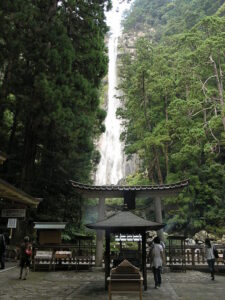
Na-chi Mi-taki, 那智御瀧, ‘What-wisdom Hon.-waterfall, and Hi-taki Jin-ja, 飛瀧神社, Leap-dragon God-shrine. The Kanji for taki, waterfall is written with two Kanji, 瀧 and 滝. Both Kanji are composed of water, 氵, and dragon, 龍 and 竜.
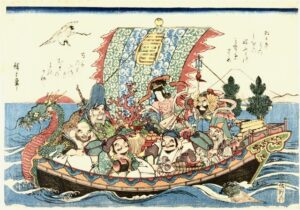
Color woodblock print of the Shichi-fuku-jin, 七福神, Seven-fortune-gods, riding in the Ryū no Takara-bune, 龍の宝船, Dragon-’s Fortune-boat; by Uta-gawa Hiro-shige, 歌川 広重, Song-river Wide-tiers; 18th century.
One of the New Year’s features is a figural representation of picture of the Shichi-fuku-jin, 七福神, Seven-fortune-gods, riding in a boat, Ryū no Takara-bune, 龍の宝船, Dragon-’s Fortune-boat, which is in the form of a dragon. The gods sail from the island of Hō-rai-san, 蓬莱山, Mugwort-goosefoot-mountain, to Japan on New Year’s Day.

Kake-mono, 掛物, hang-thing, with calligraphic Kanji, taki, 瀧, waterfall, by, Hashi-moto Jō-shō, 橋本紹尚, Bridge-origin Help-further, of Hō-toku-ji, 芳徳寺, Fragrant-virtue-temple, Yagyū, Nara. Formerly of Dai-toku-ji, 大徳寺, Great-virtue-temple, Kyōto. Photo Rakuten. The scroll is signed Zen-dai-toku Ya-gyū Jō-shō, 前大徳柳生紹尚, Prior-great-virtue Willow-live Help-further.
The Kanji, 瀧, on the hanging scroll, is written with one of the lines extending downward, emulates the concept of a waterfall. This is a typical manner of writing this particular Kanji.
The Kanji for taki, 瀧, 滝, waterfall, is composed of water and the Kanji for dragon and the zodiac sign for dragon.
There are countless kakemono of paintings of waterfalls, which are often displayed in the tokonoma during the summer months to give a cool feeling. Some of these pictures include one or more images of koi fish swimming up the waterfall. Many paintings with only a waterfall, the koi is implied, which is a symbolic aspect of attaining Buddhist enlightenment. The koi represents an aspect of the maturation of the nervous system. Upon reaching the pool of water which is source of the waterfall, the koi fish is transformed into a dragon, a Buddhist symbol of enlightenment.
It is said that a picture is worth a thousand words, however, a word can be worth a thousand pictures, at least in one’s mind. Seeing a picture of a waterfall is exactly that, a waterfall, whereas seeing the word ‘waterfall’, one can image a myriad of different waterfalls. This is one of the reasons that the written word is preferable to a picture as a kakemono for a Tea gathering. Seeing the word, one must think and use the mind, not just the eye.
The koi, 鯉, carp, swims up the waterfall, and upon reaching the pool above, is turned into a dragon. It is interesting to note that the koi swims up which is Yō, and the water which is In falls down, which is also In.
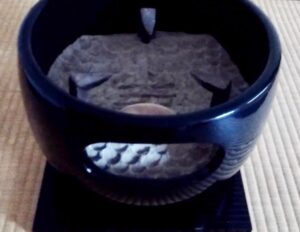
The pattern of ash laid in the portable fu-ro, 風炉, wind-hearth, which is called uroko-bai, 鱗灰, scale-ash ash indicates that the dragon is headed away from the shōmen, meaning that it is headed north toward deity and Satori. The dragon is the symbol of Enlightenment in Buddhism. The dragon figures in the development of the Kundalini.
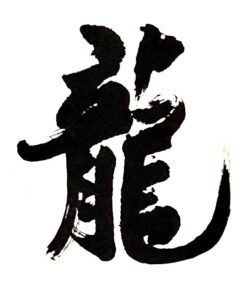
The Kanji for dragon, 龍, is read tatsu, ryō, rō, ryū, and is composed of the Kanji for tate, 立, stand, and tsuki, 月, moon, month. A dragon and the moon symbolize the connection of the sub-consciousness and nature. The moon, like the sun, and all heavenly things rise in the east. According to the ‘new’ arrangement of the hakke, 八卦, eight-signs, the east is identified with the trigram Shin, 震, quake, shake, tremble, quiver, shiver. The Kanji is composed of ame, 雨, rain, and tatsu, 辰, dragon zodiac sign. It should be remembered that the east quadrant of the sky is guarded by Sei-ryū, 青龍, Blue/green-dragon. The south quadrant is protected by Su-zaku, 朱雀, Red-bird; the west by the Bya-kko, 白虎, White-tiger; the north by the Gen-bu, 玄武, Black-warrior.
The Japanese zodiac sign of the Dragon is 辰 which is pronounced tatsu, shin, jin. Its meanings include to vibrate, time, day, season, heavenly body, stars, and is the time from 7 to 9 am, east-southeast, and is a character radical. It is an alternate name for the North Star, Polaris, Hoku-shin, 北辰, North-star. The North Star is also called, Hok-kyoku-sei, 北極星, North-extreme-star, and Ten-tei-sei, 天帝星, Heaven-emperor-star.
The sign of the northern quadrant, Gen-bu, 玄武, Black-warrior, or a creature combining a turtle and a snake, which is called ki-da, 亀蛇, turtle-snake. In the Egyptian Book of the Dead, as the Sun journeys through the sky it becomes a serpent
Hoku-shin, 北辰, North-dragon, is also depicted as a Buddhist deity riding on the back of a dragon or a turtle and snake; Hoku-shin Myō–ken Bo-satsu, 北辰妙見菩薩, North-star Wondrous-see Sacred tree-salvation, or simply Myōken Bosatsu. Myōken is depicted in many ways as a lovely person or stern warrior, standing on one foot. As the warrior the figure is black, and may be identified with Gen-bu, 玄武, Black-warrior. Some images show a red sun with image of three-legged crow in the right hand, and white moon with image of hare in the left hand. When adorned with a halo, it is decorated with seven stars of the Big Dipper constellation. Some images of Myōken have a deer’s head as a crown, because Myōken was a deer in a former life.
Myōken is also identified with Kichi-jō-ten, 吉祥天, Luck-happy-heaven. She is the wife, or sometimes the sister, of Bishamonten and is the goddess of fertility, fortune, luck, beauty, and merit. She is often depicted holding the hōju on her left hand.
Adopted from China, Japanese astronomy and astrology are almost inseparable. The heavenly lights were seen in groups called sei-shuku, 星宿, star-mansion, and sei-za, 星座, star-mansion, which in the west would be called constellations. The star groupings were organized in twenty-eight constellations, which were divided into seven constellations identified with the four directions. These quadrants were guarded by four dragons, which in time were changed into shi-jin, 四神, four-gods.
In modern astronomy, the west has established eighty-eight constellations. Of great interest is that the west identifies 88 constellations, and that Eastern thought greatly reveres the number 88, as a symbol of Infinity in Space. The constellation of Draco, was not a part of Asian astronomy, but the ancient astronomy does identify the constellation Draco, though it is called Ten-ryū-za, 天龍座, Heaven-dragon-seat. The star, Thuban [serpent], Alpha Draconis, is a binary star in the constellation of Draco, that was the Pole Star from the 4th to 2nd millennium BC.
The right side of the Kanji 龍 does not exist outside of its presence in dragon. The origin of the Kanji is a pictogram of a big-eyed creature with whiskers, that was altered into the right side of the Kanji. The Kanji 龍 is a radical and part of other Kanji such as kago, 籠, basket, which is also read komoru, komeru, komu, rō, ru, meaning basket, devote oneself, seclude oneself, cage, coop, implied. The Kanji radical for basket, 籠, is take, 竹, bamboo, not ‘dragon’. Baskets are made of many materials, and bamboo is a prime source.
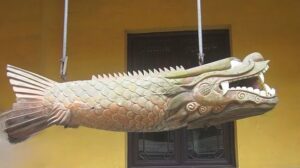
Long-yu, 龙鱼, dragon-fish, in Japanese, ryū-gyo, 龍魚, dragon-fish, wooden percussion ‘bell’ at Xi-lin Chan-sì 西林禪寺, West-grove Zen-Temple, founded in 872, Shanghai. The wooden dragon-fish is often found in Zen temples in Japan, and is used for announcements.
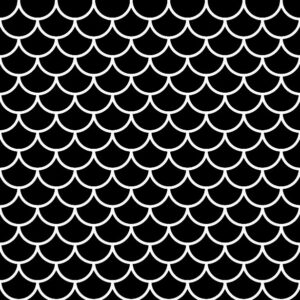
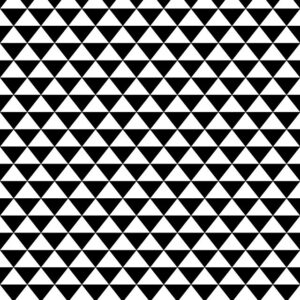
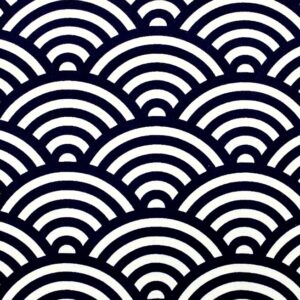
There are two different patterns identified as uroko, 鱗, scale. Sei-kai-ha, 青海波, blue-sea-wave, pattern, ideally, has a repeated overlapping designs of five arcs. The key aspect is that the pattern has the arcs facing upwards, which distinguishes it from the uroko pattern, which has the arcs facing downward.
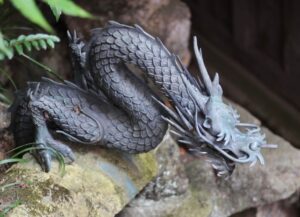
Dragon water spout at Yō-koku-ji, 楊谷寺, Willow-valley-temple. Note the scales, uroko, 鱗, of the dragon, which are likened to the scales of the koi fish. This pattern of scales is emulated in the pattern of ash laid in the portable fu-ro, 風炉, wind-hearth, which is called urokobai. With such a pattern, it may be assumed that the furo is identified with the dragon. As the dragon is the bringer of rain and water, it provides symbolic protection from fire. Dragons also bring wind and storms. The kama and some furo have lugs, kan-tsuki, 鐶付, metal ring-attach, in the form of oni, 鬼, demon, which may also be identified with dragons.
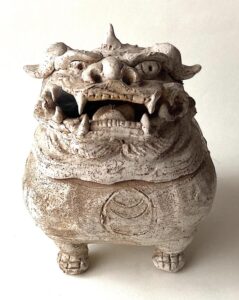
Kō-ro, 香炉, incense-hearth; ceramic object in the form of a ‘Kara ji-shi’, 唐獅子, Tang lion-of, Shi-no yaki, 志野焼, Aspire-field fired, by Mae–kawa Den-kō, 前川電光, Fore-river Lightning-light, Se-to Shi, 瀬戸市, Rapids-gate City.
The pictured creature has features that are identified with the Kara jishi, and a Koma-inu, 狛犬, ‘Korea’-dog, guardian dogs at shrines and temples. Koma is an archaic part of Korea. An important feature of the dog is a point on its head.
Shrines and temples often have pairs of guardian animals flanking entrances. The creature on the right has its mouth open, that on the left has a closed mouth, which are aspects of In and Yō. According to tradition, the lion, shishi, is on the right, the dog, inu is on the left. The incense beast has an open mouth like the lion, and a point on its head like the dog. Note the hōju motif on its chest.
The Dragon King had nine sons, Ryū-sei Kyū-shi, 竜生九子, Dragon-birth Nine-child (sons), and one of them loves and drinks water; in Mandarin the name is Bi-Xi, 贔屭, in Japanese the creature is known as, Hi-ki, Strength-power, a kind of turtle. He also can support extremely heavy weights, and in China is the foundation of monuments. Perhaps, the furo is the ‘dragon’ Hiki, that supports the kama filled with water. There are many animals that appear to be a lion or a dog, that may be identified as one of the nine sons of the Dragon King.
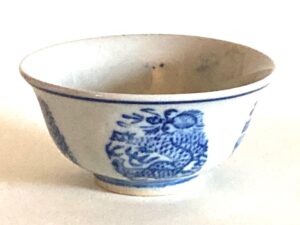
Meshi ja-wan, 飯茶碗, rice tea-bowl, also called meshi-wan; some-tsuke, 染付, dye-attach, porcelain with four transfer print blue glaze designs of a dragon in a roundel, Se-to-yaki, 瀬戸焼, Rapids-door-fired, likely Taishō period; diam. 3.5 sun kane-jaku. Although such bowls are infrequently seen in the Tearoom, they a part of daily life in Japan filled with rice, and often topped with ryoku-cha, 緑茶, green tea – o-cha-zuke, お茶漬け, hon.-tea-steep.
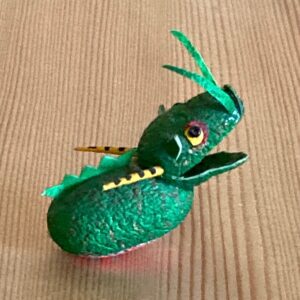
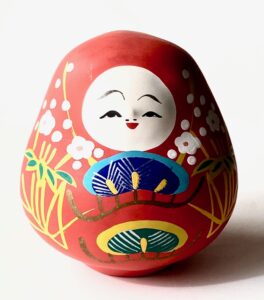
First picture: toy dragon made of mayu sai-ku, 繭細工, cocoon work-craft. A few kaiko no mayu, 蚕の繭, silkworm’s cocoon, were made into a wobble toy tatsu, 龍, dragon; L. 2 sun kane-jaku.
Second picture: hachi-man oki-agari nin-gyō, 八幡起き上がり人形, Eight-pennants get-up person-form, papier-mâché doll made in Ka-ga, 加賀, Add-joy. Hachiman, the god of war, swaddled in red like a new-born, looks a lot like Daruma. This very popular wobble doll is made in a wide range of sizes. It is decorated with New Year emblems; shō chiku bai, 松竹梅, pine-bamboo-prunus. Hachiman, venerated in both Shintō and Buddhism, is associated with dragons, wind, and water.
The Japanese people love toys, and have made little figures out of silk cocoons. Some have a weight inside that causes the toy to always remain upright, which is called oki-agari, 起き上がり, rise-up. Millions of weighted images of Daruma dolls have been made that always sit upright. The Japanese word for the toy’s wobbly action is koro koro, ころころ.
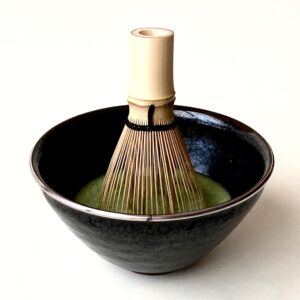
One of the Japanese words for dragon is tatsu, and tatsu may be wordplay in the phrase, ‘cha wo tatsu’, 茶を立つ, tea is rise, to make tea. The Kanji 立, has many different readings, and a multitude of translations, many having the concept of ‘upward’.
For further study, see also: Dragon in Chanoyu, Anatomy of Japanese Tea Ceremony: Lecture 3 The Five Elements and the Ekikyō, Unryū Gama– Article, Unryū Gama – A Petal Puzzle, Unryū Gama Picture Gallery, and search Dragon

